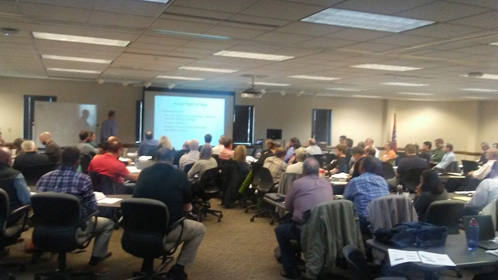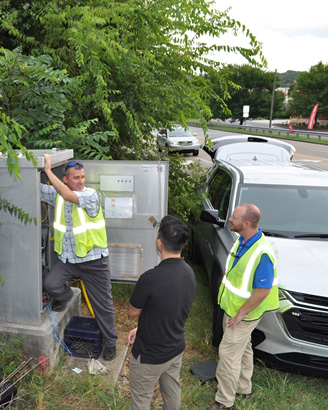FHWA brings workshop on ATSPMs to Tennessee
by Airton Kohls
On October 30th, the Federal Highway Administration in collaboration with its Tennessee Division Office, the Tennessee Department of Transportation and the University of Tennessee Center for Transportation Research held a free, one-day workshop in Knoxville on the use of Automated Traffic Signal Performance Measures (ATSPMs). In attendance were 71 people representing 19 government agencies, 16 consultant firms and 5 equipment companies.
First, a little bit of background... The Federal Highway Administration (FHWA) is continuing to promote ATSPMs from the Every Day Counts (EDC-4) initiative as a means to improve on the traditional traffic signal retiming processes by providing continuous performance monitoring capability. Signal retiming efforts can be based directly on actual performance without dependence on software modeling or expensive, manually collected data. ATSPMs consist of a high-resolution data-logging capability added to existing traffic signal infrastructure and data analysis techniques. This provides agency professionals with the information needed to proactively identify and correct deficiencies. They can then manage traffic signal maintenance and operations in support of an agency's safety, livability and mobility goals.

Back to the workshop details… Mr. Rick Denney, from the FHWA Resource Center, got the day started elaborating on “an objectives-based approach to signal operations and measurement”. He demonstrated how different signal performance measures can assist practitioners to achieve their carefully selected operational objectives. Operational objectives that can vary from assigning intersection right of way in a safe manner to minimizing phase failures during light flow, to selecting smooth flow or equitable service during uncongested flow, to finally maximizing throughput or managing queues during congested flow. Remember, signal timing is not one size fits all!
Dr. Christopher Day, from Iowa State University detailed the requirements of the ATSPMs system, including data collection, communications and detection requirements. He also provided very detailed case studies of how ATSPMs helped his team fine tune traffic signal systems and improve operations on facilities in Indiana. Mr. Justin Effinger, a traffic signal engineer from Lake County in Illinois, pointed to how his agency is implementing and using ATSPMs. One interesting example was the use of signal performance measures, more specifically the split monitor, to address common citizen complaints, like “I am not being served at the traffic signal”.
During the afternoon sessions, two different business models for ATSPMs were presented. First, the city of Cleveland, TN, represented by Mr. David Sheely and Mr. Tad Bacon (Cleveland Utilities) presented their recently deployed Miovision system that collects and generates reports on ATSPMs. Here, the system was purchased from the vendor which allows the agency to bypass the need for in-house data storage and maintenance. Even though just a few days of data were being analyzed, the city pointed to the benefits of a study corridor health-check report that portrayed potential operational issues to be addressed. For instance, in one intersection a side street through movement was “diagnosed” with a minimum green larger than typical. After the adjustment, the signal performance measures analysis yielded a 14% improvement in simple delay during the PM peak period for the major street.
Addressing a different business model of ATSPMs use, the city of Sevierville, TN, represented by Mr. Bryon Fortner and Mr. Eric Itzel presented on their adoption of ATSPMs using the UTAH DOT open source code (https://udottraffic.utah.gov/ATSPM/Home/About) plus an on-premise server running Windows Server, IIS and SQL 2016. The city of Sevierville started implementation of ATSPMs in 2016 and has used it in innovative ways, including to check results of a coordination retiming project, to demonstrate effects of new developments at signalized intersections and to check activity of a remote detector used to conditionally call a blankout sign at the Eastbound ramp at the diverging diamond with I-40.

Furthermore, Mr. James Hagermann, Mr. Jeffery Branham and Mr. Ernie Pierce from the city of Knoxville hosted a meeting the next morning at the Public Works Service Center and demonstrated some of the city's initiatives on advanced transportation technologies, including traffic signals, parking meters, school zones beacons, etc.
Finally, I believe the workshop presented a great opportunity for practitioners to learn more, network and create collaborative efforts for using ATSPMs in Tennessee. It is necessary to recognize and thank everyone that collaborated to make this a special and successful event, including the workshop presenters, as well as Mr. Charles Lattimer (Atkins), Mrs. Pamela Heimsness and Mrs. Melissa Furlong (FHWA TN Division Office), Mr. Steve Bryan (TDOT Headquarters), Barge Design Solutions and CDM Smith (lunch sponsors) and all participants.
Back-Contents-Forward